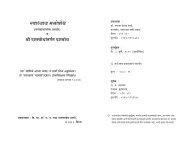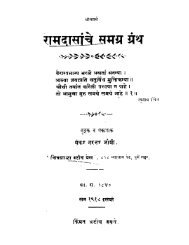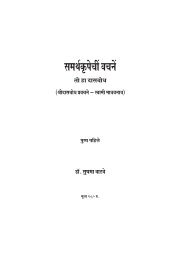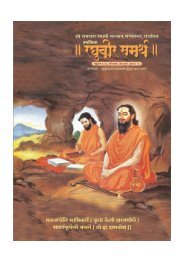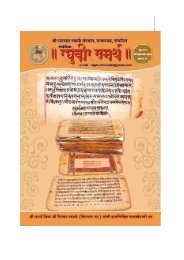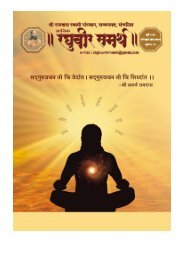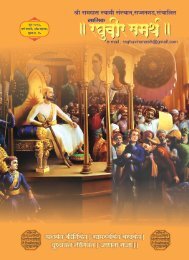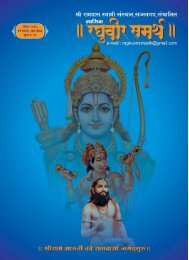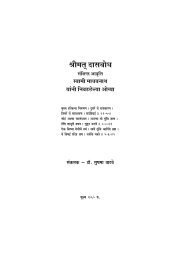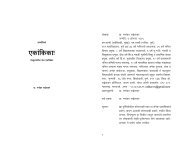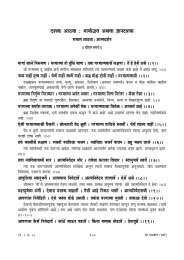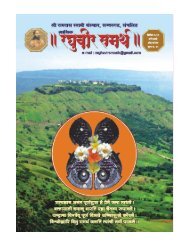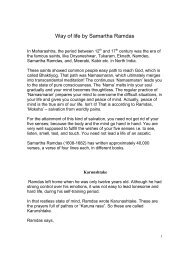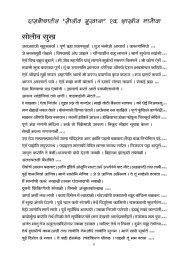THE DASBODHA BY: SADGURU SHREE SAMARTH RAMDAS ...
THE DASBODHA BY: SADGURU SHREE SAMARTH RAMDAS ...
THE DASBODHA BY: SADGURU SHREE SAMARTH RAMDAS ...
You also want an ePaper? Increase the reach of your titles
YUMPU automatically turns print PDFs into web optimized ePapers that Google loves.
Panchman, Manpanchak, Janaswabhawgosavi, Panchsamasi, Saptsamasi, Sagundhyan,<br />
Nirgundhyan, Junatpurush, Shadripunirupan, Panchikaranyog, Manache Shlok, Shreemat Dasbodha<br />
and many other unpublished works. Although in the Dasbodha he has stressed incessantly upon<br />
wisdom, he was a staunch believer in hard work. This is what he advocated while leading the daily<br />
life, yet he was an extremely kind hearted man which is most evident from his Karunashtakas. He<br />
was gifted with literary genius which was available for him anytime of the day or night for he<br />
almost never slept! His specialty was that although when he was touching the abstract philosophy<br />
during his thinking before he wrote, his writing was so simple that even the illiterates understood it<br />
if read for them. Another facet of his writings was straightforwardness and unhesitant approach. He<br />
used to write or dictate very fast and never paid attention if he had to use Hindi, Urdu, Arabic or<br />
Sanskrit words so long as his writing remained simple. He even introduced new words to these<br />
languages in the flow of his writing. In fact many of his sentences have become a treasure of<br />
phrases in the Marathi language. His language on top of this was very forceful. His success as a<br />
writer remained in the fact that he could convey what he wanted to tell exactly in the least possible<br />
number of words. His sentences used to be small in length but the meaning they conveyed was<br />
enormous. All in all his writings have left an indelible mark not only in Marathi but the World<br />
literature also.<br />
<strong>SHREE</strong>MAT <strong>DASBODHA</strong><br />
Dasbodha is an epic written by Shree Samarth. Whatever he wanted<br />
to tell the world he has conveyed through Dasbodha in a very candid manner. As per the tradition<br />
in his times he wrote it in the Owi form. The contents of the book are very simple, straightforward<br />
and easy to understand. It is so simple that sometimes it seems to be a prose. Dasbodha is divided<br />
in 20 main parts called as Dashak each of which contains 10 sub parts which are called as Samasas.<br />
The total Owis number 7751. Each Owi is made up of 4 lines. After being blessed by Lord Ram he<br />
wrote the Old Dasbodha. One finds the freshness, fearlessness and candidness of a person blessed<br />
with the ultimate knowledge just recently in it. After a while he started with the continuation of the<br />
work and completed up to the 7 th Dashak to which he added the Dashak he had written earlier,<br />
called the Dashak of knowledge. Then throughout his life he continued writing for the Dasbodha<br />
which amounted to another 12 Dashaks. These were added to the earlier 8 ones and the final<br />
volume of the Dasbodha as we know it now was prepared just 2 months prior to the time when<br />
Shree Samarth left his mortal body. At the end of the book he has as always very unassumingly yet<br />
candidly asked the readers to study, ponder over, introspect and not just only read the whole<br />
Dasbodha! That is vintage Shree Samarth for everyone!<br />
<strong>SHREE</strong> <strong>SAMARTH</strong>’S VIEW OF LIFE<br />
The view of life in general which Shree Samarth has advocated in the<br />
Dasbodha is that of a singular existence of the body and the God or the Parbrahma. He has<br />
profoundly refuted the theory of the dual existence because by definition the duality is temporary,



